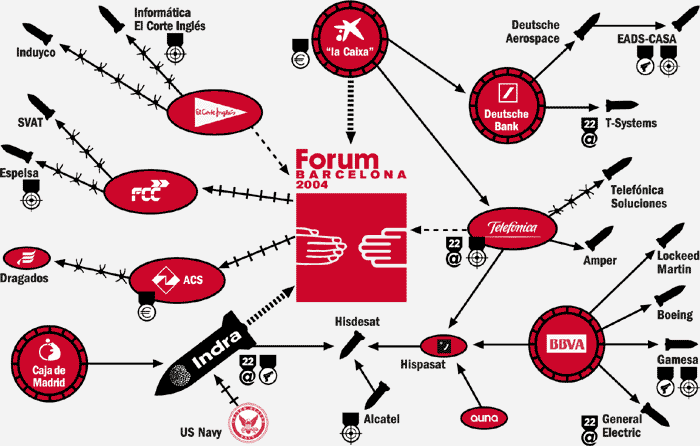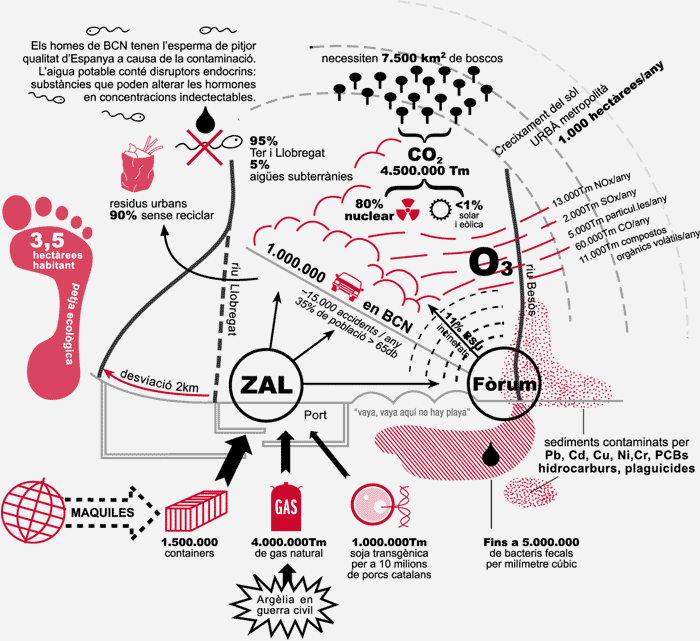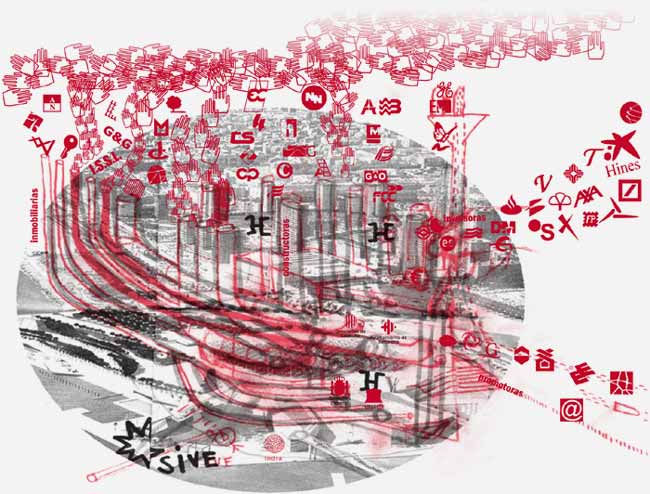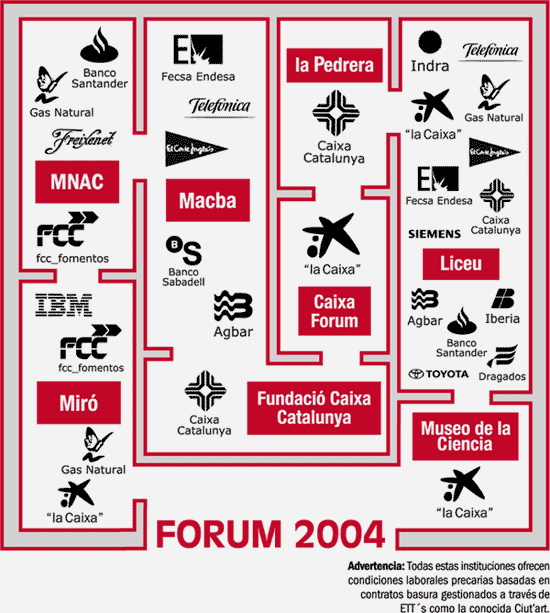|
In
this map we intend to show the links between Forum 2004
and the war economy. You may see that a significant part
of the enterprises that are sponsors or partners of Forum
2004 are either weapons systems builders or have a share
in such enterprises. Some of the Forum 2004 enterprises
are members of the strong military industry lobbies in Spain,
have direct economic interests in post war Iraq or supply
several armed services, US Navy among them, with military
equipment.
You may also see some of the war related enterprises that
will settle in 22@ in Poblenou, a neighbourhood that, according
to the City Council of Barcelona, is to become «a
paradigm of the land use mix that should represent a quantum
leap in our way of making a city». In any case, it’s
quite evident that Barcelona, the «city of peace» is to become a paradise for the settlement of high tech
war related corporations and an important node in the network
of design, production and sales of weapons that is being
woven around the planet. The map clearly shows one of the
main paradoxes of Forum 2004, i.e., that an event which
is meant to discuss the conditions for peace is sponsored
by corporations that make profit from armed conflict and
is, in this way, establishing the conditions for war.
|
 |
|
The map is of all. Download this diagram and use it. .zip
(376K)
|
|
|
Lower
Besòs river area
Forum 2004, built on the banks of Besòs River, has
set off the programmed substitution of artificial landscapes
for natural biodiversity —at a huge energetic cost.
Water in that river is as polluted as it has been for a
long time, because of inadequate sewerage systems that actually
dump polluted water into the river —up to ten times
its natural water flow. Instead of improving its environmental
quality, the riverbed has been covered with lawn, banks
have been covered with concrete and the river itself has
been diverted into the water treatment plant at the Forum.
This lawn, an absurd patchwork for jogging set in a place
where one should find the river and the riverbank forest,
is actually built on a huge dump of waste no one ever bothered
to treat.
The riverbed section between the mouth and Mollet del Vallés
has actually been turned into an illegal chemical waste
dump that has polluted large underground water reserves.
During the building of Forum 2004 alone, tens of thousands
of tons of toxic soil (with heavy metals such as chromium)
had to be removed. But if you look at all this from the
newly built Forum bridge, you’ll see it as green and
as pretty as a festival of “metapolitan” carpets
and avant-garde architecture. One wonders: Is the lawn on
the Besòs real?
ZAL
Zona d’Activitats Logístiques/Logistic Activity
Area. Barcelona’s great bet into the future is the
traffic of manufactured goods, shipped in on a 1.5 million
containers —growing by 10 per cent every year. Such
goods are manufactured in Asia and Latin America under new
forms of labour exploitation: the infamous maquilas, isolated
industrial areas where hundreds of thousands work very close
to slavery (like in Ciudad Juárez, Mexico). Logistic
activity areas, usually in large harbours and almost tax
free, and the massive use of containers (easily shifted
from ships into trains or lorries), help multinational corporations
to force Third World production areas to compete with each
other deteriorating wage levels and the environment, as
well as to strengthen their grip on supermarket–city
shops, which are able to save on import and stocking costs
if they accept global goods. That’s why we find the
same shops all over the world. Barcelona plans to enlarge
tenfold its ZAL, which will double the harbour in size.
To do so, the Llobregat River will be diverted and its mouth
actually moved a mile and a half to the south, destroying
natural delta marshes that are very important for birds
(they’re actually ZEPA and PEIN areas protected under
the Bern Convention).
This gigantic operation was launched under the motto “Barcelona,
la botiga més gran del món” (Barcelona,
the largest shop in the world). It intends to turn the city
into a huge shopping mall and a euromediterra-nean logistic
centre —under the coverage of a “culture Forum”.
No wonder the main corporations supporting the Forum are
investing in the new harbour or in the Zona Franca.
Sea and beaches
Yachting harbours are responsible for the loss of sand on
the beaches. After a building fever during the nineties,
a moratorium was established —only to be broken by
the new marinas at Forum and Sant Adrià. The loss
of sand is huge. Every year, regeneration programs are carried
out at an unsustainable economic and environmental cost
—new sand is brought from the seabed, which is in
its turn devastated.
Freshwater from the Besòs River would carry millions
of faecal bacteria per cubic meter into the Olympic beaches,
were it not diverted into the Forum treatment plant and
dumped into the sea about half a mile from the shore. Sea
water at the shore contains 14 different polycyclic carbohydrates,
most of them carcinogenic, usually coming from ships, as
well as different amounts of lead, chromium, copper, cadmium,
iron and manganese, plus tensioactives (from detergents),
PCB organoclorates (very carcinogenic), pesticides and hydrocarbons.
Concentrations may sometimes be very high and pollute beaches
all the way down to the Barceloneta. All these pollutants
are not taken into account in summer beach quality reports
—only faecal bacteria are, and samples are taken only
on the surface. Until five years ago, both Montcada and Sant Adrià
water treatment plants were dumping 500 tons of toxic mud
per day (during 20 years) into the sea just in front of
the Forum area. They have created an underwater toxic island
that will continue to free its toxic substances for many
years to come. These substances find their way into fish
and seafood —in an area where fishing is usual.
|
 |
The map is of all. Download this diagram and use it. .zip
(376K)
|
|
|
Forum
2004 sees «cultural diversity» as the cause
of injustice and social inequality, and the good will of
citizens as the main solution for such issues. Faithfully
serving corporate interests, Forum 2004 conceals practices
of entrepreneurial imperialism that force thousands of people
to emigrate as well as the legal system that doesn’t
accept immigrants as citizens, forces them into exploitation
and continuous police control. By concealing things this
way, the official discourse intends to deactivate any social
project that might endanger the interests of those who benefit
from the oppression and precariousness of people.
The map shows the links between corporations and institutions
that sponsor Forum 2004 and the Africans, Asians and Latin
Americans that live in Barcelona in poverty and out of the
law —most of those who live here. Only some of those
links appear actually on the picture —just a small
sample.
|
The map is of all. Download this diagram and use it.
.zip (376K)
|
|
|
Forum
2004 is the big ad, the glossy decoy designed to lure profiteers
into the largest property speculation operation in the history
of Barcelona (a city that has already known quite a few).
Those who are benefiting from this operation like to call
it urban redevelopment. You may check the red areas, labelled
especulació, on the general map.
What’s this urban redevelopment really about? Let’s
take a closer look at Poblenou, the neighbourhood in which
the 22@ project is being developed. Forum 2004 is actually
nothing but the best known and friendliest side of the 22@
redevelopment project.
The City Council of Barcelona is or, rather, was the landowner
of a large part of the industrial land in Poblenou. It was,
because the City Council has sold most of it to property
developers, building companies and large corporations, most
of which are well known as the main builders and sponsors
of Forum 2004.
La Caixa, through Servihabitat, owns 50,000 square meters;
Endesa, through the AUNA group, owns 12,764; Agbar owns
5,000; Indra too owns a significant lot.
The relationship, which no one would dare call not–for–profit,
between these corporations and Forum 2004 has begun to yield
huge profits. Consorci de la Zona Franca, for instance,
has announced a 434 per cent profit during the last 8 years.
By the way, Consorcio Zona Franca is building the Forum
2004 offices and has recently bought the Sant Andreu barracks,
from which squatters have just been evicted. In Poblenou
alone, more than 1,200 families have been or are to be evicted
from their homes, and more than 1,000 small shops will have
to close. On the other hand, the Diagonal Mar area, a formerly
public space which has been turned into private hands and
is now strictly policed by private armed guards, is thriving.
To put it briefly: instead of using this publicly owned
land (at no cost at all) to improve the living conditions
of neighbours (by building schools, parks, social housing
or hospitals), the City Council sells it to multinational
corporations.
This urban redevelopment devastates neighbourhoods and expels
their inhabitants, paying them small compensations, which
are calculated on the basis of property register values
and not of market values. This means that former neighbours
have to buy new homes at a much higher price and have no
choice but to get into debt. It’s more and more usual
to see how urban landscape is turned into an unliveable
and unaffordable theme park. “Barcelona, la botiga
més gran del món” [the largest shop
in the world].
There’s no need to say that these redevelopment projects
can only be carried out by means of repressive policies
(mobbing, menacing and cheating neighbours). No one will
easily accept to be deprived of the right to have a home,
not even under the threat of being criminalised or of having
to live in precariousness. That may explain that neighbours
are organising against 22@ and Forum 2004, and that squatting
has become widespread in this area.
|
 |
The map is of all. Download this diagram and use it.
.zip (376K)
|
|
|
Forum
2004 SA is nothing but the most cynical and absurd exaggeration
of what we nowadays know as a Cultural Institution. In the
diagram, you’ll find just some of the institutions
taking part in Forum. You can see there is a pattern in
the way many of these act: they are public institutions
strongly sponsored (and, thus, controlled) by multinational
corporations, and support the economic and ideological interests
of those corporations. As the director of the City Council
Culture Institute put it, “these corporations’
commitment to culture gives them prestige, good reputation…
and profits”.
Profits shape the (single-minded) thought and the cultural
taste (the same for everybody) —they shape culture.
Multiculturalism, as you will find it in Forum 2004, is
nothing but a fake of diversity in which everybody has a
place as long as they stick to the stereotype: Chinese must
play Chinese, Africans must play African, the “alternative”
must play “alternative”. By the way, the Chinese
that will act every day during the Forum were supposed to
be French —but they were too expensive.
The rainbow may have many colours, but multicultural culture
has only one: the colour of money.
|

WARNING: All these institutions
offer junk jobs through interim agencies such as Ciut’art.
|
The map is of all. Download this diagram and use it. .zip
(376K)
|
|
|